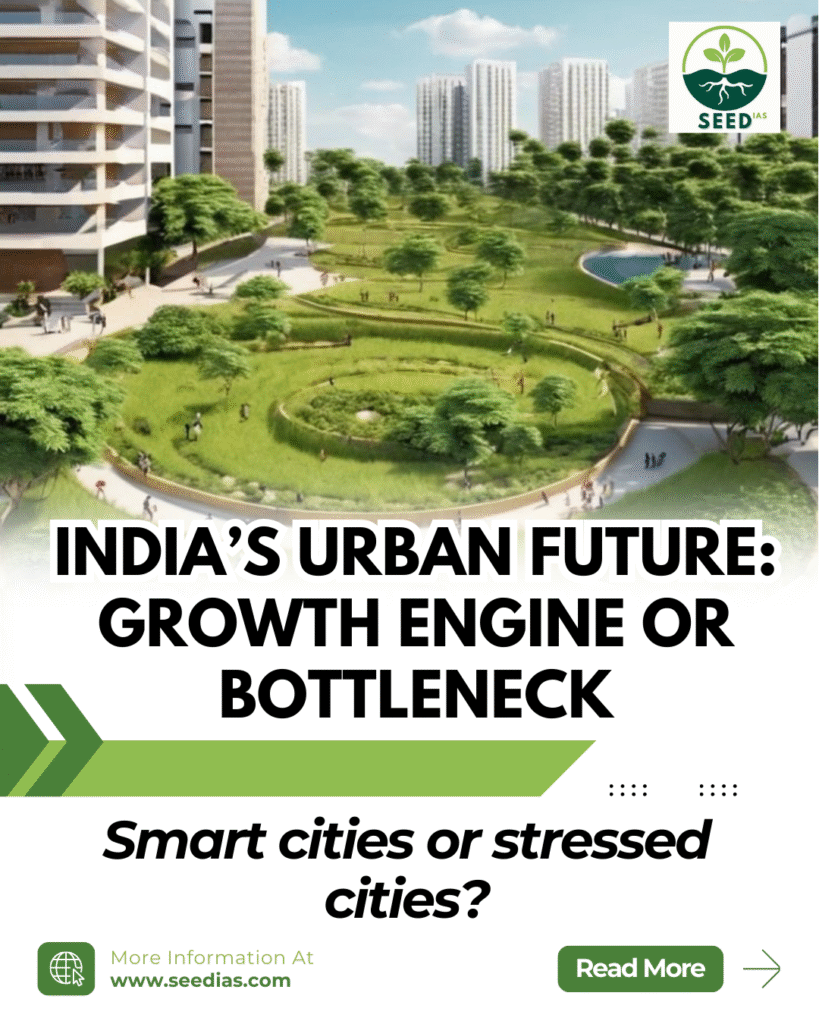Why in NEWS
India is rapidly urbanising, with 675 million people expected to live in urban areas by 2035 and an additional 70 million by 2045. While this transition promises economic and social transformation, deep-rooted urban challenges threaten to derail its full potential.
Key Concepts and Definitions
| Term | Definition |
|---|---|
| Urbanisation | The increasing number of people living in towns and cities. |
| Agglomeration Economies | Economic benefits that result when firms and people locate near one another. |
| Urban Heat Island | Localised increase in temperature in urban areas due to human activities. |
| PPP (Public-Private Partnership) | A collaborative investment model involving the government and private sector. |
| Transit-Oriented Development | Urban development that maximizes access to public transport. |
Why Are Cities Central to India’s Economic Future?
| Factor | Details |
|---|---|
| Economic Engines | Cities contribute ~60% of GDP while occupying only 3% of land. |
| Top Contributors | 15 cities (e.g., Mumbai, Delhi, Bengaluru) account for 30% of GDP. |
| Agglomeration | Dense urban centres enhance job creation, innovation, and output. |
| Global Competitiveness | Well-managed cities attract FDI and improve ease of doing business. |
| Infrastructure Gains | Efficient urban systems lower logistics costs, aiding industries. |
| Innovation Hubs | Cities drive R&D, digital growth, and startup ecosystems. |
| Social Development | Urbanisation improves access to education, health, and jobs. |
Challenges Faced by Urban India
| Challenge | Details |
|---|---|
| Traffic Congestion | Daily average delay: 1.5–2 hrs; inefficiencies cost India $22B annually. |
| Air Pollution | 42 of world’s 50 most polluted cities in India (2023); major cause of respiratory diseases. |
| Water Scarcity | 40–50% of urban piped water lost in transmission; many rivers polluted. |
| Solid Waste | 150,000+ tonnes/day generated; low recycling rates, poor segregation. |
| Sanitation Gaps | Informal settlements lack sewage and sanitation facilities. |
| Housing Shortage | 10 million-unit gap, projected to triple by 2030; slum population rising. |
| Urban Flooding | Caused by poor drainage and encroachments; eg. Kerala (2018), Chennai (2015). |
| Municipal Finance | Local bodies raise <0.2% of GDP; property tax revenues very low. |
| Digital Deficits | Poor internet speed slows down tech growth and city administration. |
| Urban Heat Island | Leads to AC overuse, power demand, water stress, and health impacts. |
Major Government Initiatives in Urban Sector
| Initiative | Focus Area |
|---|---|
| Swachh Bharat Mission | Cleanliness and sanitation |
| Smart Cities Mission | Sustainable, tech-enabled urban development |
| PM SVANidhi | Credit support to street vendors |
| AMRUT | Urban water supply and sewerage |
| PM Awas Yojana (Urban) | Affordable housing for urban poor |
| NULM (Urban Livelihood Mission) | Employment opportunities for urban poor |
| Special Assistance for Capital Investment | State-level urban infrastructure development |
What Reforms are Needed for India’s Urban Future?
| Reform Area | Proposed Measures |
|---|---|
| Core Infrastructure Status | Treat urban infra on par with highways/ports for funding priority. |
| Integrated Development | Align housing, transport, and industry under Transit-Oriented Development. |
| Unified Urban Governance | Create tech-enabled bodies with private-public collaboration; use urban digital twins. |
| Sanitation as Economic Priority | BOOT models (e.g., Tirupur Water Project); involve industry in circular economy & sanitation. |
| PPP Redesign | Use viability gap funding, challenge funds to boost brownfield and greenfield urban projects. |
| Digital Backbone Co-Development | Deploy AI, real-time data for infrastructure and governance. |
| Climate Resilience | Invest in flood barriers, green roofs, urban forestry, and heat-resistant structures. |
| Citizen-Industry Participation | Build inclusive frameworks for decision-making; urban reform as a collaborative process. |
In a Nutshell
Memory Code – “CITIES FIGHT BACK”
Congestion
Infrastructure
Tech deficits
Innovation
Environment
Sanitation
→ FIGHT BACK with reforms, PPPs, citizen engagement, and sustainable planning!
Prelims Practice Questions
- Which of the following initiatives focuses primarily on affordable housing in urban India?
A) Smart Cities Mission
B) PM SVANidhi
C) PM Awas Yojana (Urban)
D) AMRUT - What is the main purpose of urban digital twins?
A) Provide backup data servers for cities
B) Build replicas of cities in rural areas
C) Integrate tech systems for real-time city governance
D) Predict urban migration trends - Consider the following statements:
- Indian cities occupy less than 5% of India’s land area but contribute over 50% of GDP.
- India raises over 1% of GDP from property tax revenues in urban areas.
Which of the above is/are correct?
A) Only 1
B) Only 2
C) Both 1 and 2
D) Neither 1 nor 2
Mains Questions
- Discuss the major urban challenges in India and evaluate the role of government initiatives in addressing them. (GS Paper 1/2 – Urbanisation)
- India’s urban growth can be a demographic dividend or a disaster. Critically examine with examples. (GS Paper 3 – Infrastructure/Development)
Answers to Prelims Questions
| Question | Correct Answer | Explanation |
|---|---|---|
| 1 | C | PM Awas Yojana (Urban) targets housing for the urban poor. |
| 2 | C | Urban digital twins provide real-time data for better urban governance. |
| 3 | A | Statement 1 is true. Statement 2 is false—India raises less than 0.2% via property tax. |
















